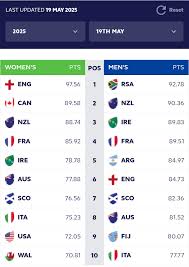Current Rugby World Rankings and Their Implications

Introduction
The Rugby World Rankings serve as a critical measure of the performance of international teams, reflecting their achievements on the field across various tournaments. As rugby continues to grow in popularity globally, these rankings carry significant weight in determining seedings for competitions such as the Rugby World Cup and other international fixtures. Understanding the current standings is essential for fans, players, and sports analysts alike as they prepare for upcoming matches and tournaments.
Current Rankings Overview
As of October 2023, the Rugby World Rankings are topped by South Africa, the reigning Rugby World Cup champions, who recently claimed their title during the tournament held in France. Following closely are New Zealand in second place and England in third, both having shown impressive performances in the recent international fixtures and the World Cup itself. Ireland, previously leading the rankings prior to the World Cup, has slipped to fourth place after their quarter-final exit.
The current rankings provide insight into the strengths and weaknesses of the leading teams. South Africa’s formidable playing style and robust tactics under their coach have cemented their position at the top. New Zealand, known for their dynamic game, continues to evolve, while England’s consistency is showcased through their hard-fought matches this year. Meanwhile, Ireland’s recent setbacks emphasise the competitive nature of international rugby and suggest that the upcoming Six Nations Championship could be pivotal for their aspirations to reclaim their position.
Implications of the Rankings
The Rugby World Rankings not only reflect historical data but also shape the future of competitive rugby. These rankings influence seeding in tournaments, with higher-ranked teams enjoying potentially easier paths to success in knockout stages. The rankings are updated weekly based on match results, thus creating a dynamic competitive environment where teams must consistently perform well to maintain or improve their position.
Furthermore, the rankings also affect financial aspects of the sport, including sponsorship opportunities and broadcast rights, as higher-ranked teams tend to attract more viewers and generate greater interest from commercial partners.
Conclusion
The Rugby World Rankings are more than just a reflection of current team performance; they encapsulate the ongoing evolution of rugby as a global sport. With every match leading to potential shifts in rankings, teams are under pressure to deliver their best performances. The current standings indicate an exciting landscape for the future of international rugby, with upcoming tournaments such as the Six Nations promising to be crucial for teams looking to assert dominance and improve their rankings. For fans and players alike, these rankings serve as a focal point, sparking discussions and debates about the best teams in the world.








